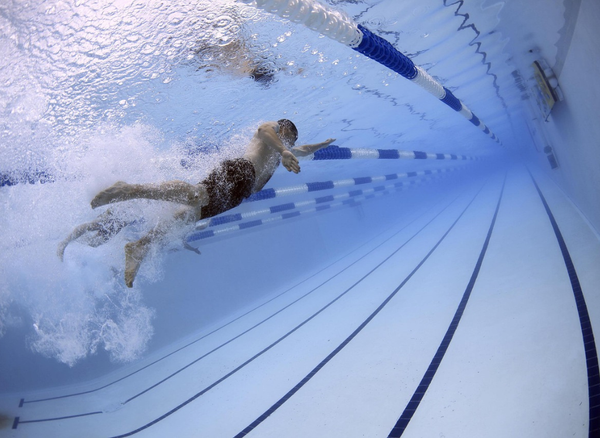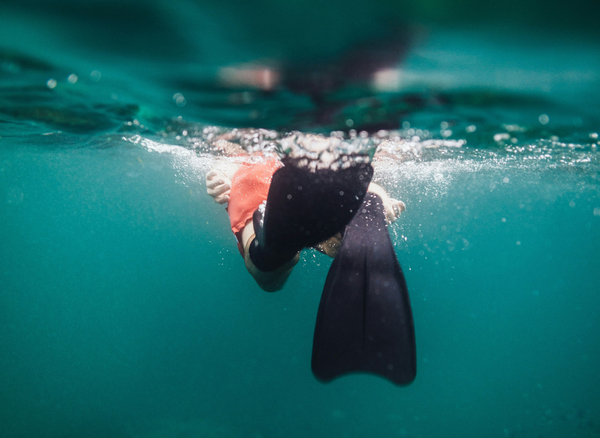Once upon a time, in the murky depths of swimming history, early fins were nothing more than clunky contraptions strapped to the feet of adventurous souls. These pioneers of the ocean were probably the first to realize that adding a little extra surface area to their feet could help them swim faster.
Fast forward to today, and swim fins have evolved into sleek, efficient tools that help swimmers glide through water like dolphins on a caffeine high.
The evolution of swim fins has been as varied as a box of chocolates. From long blade fins that make you feel like a mermaid to short blade fins that are perfect for lap swimmers, there's a fin for every foot and every swimming style. Whether you're a scuba diver exploring the ocean's depths or a competitive swimmer training to shave seconds off your time, there's a pair of fins designed just for you.
In general, there are fins in various styles tailored to unique needs. For instance,
-
Snorkelers benefit from lightweight and flexible fins, which provide ease of movement and comfort for extended surface swimming.
-
Scuba divers, on the other hand, prefer robust and powerful fins that enhance maneuverability and stability underwater, allowing for controlled movements even in strong currents.
-
Freedivers rely on long, streamlined fins designed for efficient propulsion, enabling them to glide effortlessly through the water with minimal energy expenditure.
Each type of fin is crafted to enhance the user's experience, making aquatic exploration more enjoyable and effective.
Enhancing Your Swimming Experience with the Right Fins
The right pair of fins can transform your swimming experience, making it more enjoyable and efficient. Whether you're a beginner or a seasoned swimmer, choosing fins that match your skill level and swimming goals is essential. Consider factors such as heel design, blade length, and material when selecting fins to ensure they meet your needs.
For those new to swimming, starting with a pair of fins that offer a comfortable fit and easy adjustment is advisable. As you become more experienced, you can experiment with different fin designs to find the perfect match for your swimming style and preferences.
Long Blade Fins vs. Short Blade Fins
When it comes to swim fins, one of the most significant distinctions is between long blade fins and short blade fins.
Long Blade Fins
Long blade fins are the go-to choice for those who dream of swimming with the grace of a mermaid. These fins require a bit more leg strength and endurance, making them ideal for more experienced swimmers. If you're new to the fin game, you might find yourself floundering like a fish out of water. But with practice, you'll soon be swimming with the best of them, leaving a trail of bubbles in your wake.
Long blade fins are used by scuba divers who require more power and propulsion. And there are the very long fins used by freedivers, providing a much larger surface area that helps freedivers dive through water with less effort.
Short Blade Fins
On the other hand, short blade fins are favored by snorkelers or those focusing on swim training. They are the sprinter's secret weapon, helping swimmers improve their kick cycle and body position. So, if you're looking to improve your crawl stroke or dolphin kick, a pair of short fins might be just what you need.
Open Heel vs. Full Foot Fins
When it comes to choosing between open heel fins and full foot fins, it's a bit like choosing between a convertible and a sedan. Open heel fins come with a heel strap, allowing for a customizable fit that's perfect for those with a shoe size that falls between the cracks. They're great for scuba divers who need to wear them over booties in cold or fresh water.
On the other hand, full foot fins cover the entire foot, providing a snug fit that's perfect for regular swimming in warmer waters. They're often made of soft rubber, making them comfortable to wear with bare feet. The choice between open heel and full foot fins often comes down to personal preference and the specific conditions in which you'll be swimming.
Vented Fins and Split Fins
Vented fins and split fins are two innovative designs that have gained popularity among swimmers and divers.
These fins are ideal for those who want to swim faster without exerting more effort, making them a favorite among more experienced swimmers.
Split fins, on the other hand, are designed to mimic the natural movement of a fish's tail. The split design allows for a more efficient power stroke, reducing the effort needed to propel yourself through the water. These fins are perfect for those who want to swim faster without putting in more effort, making them a favorite among both recreational and competitive swimmers.
Choosing the Best Fins for Your Needs
Selecting the right pair of fins depends on several factors, including your swimming goals, skill level, and the type of water you'll be swimming in. For those focused on swim workouts and improving leg strength, training fins with a shorter blade are ideal. These fins help enhance leg endurance and improve body position in the water.
For scuba divers and open water swimmers, longer fins with an open heel design provide the necessary propulsion and comfort for extended periods in the water. It's essential to consider your shoe size and the fit of the foot pocket to ensure maximum comfort and performance.
Fin Designs on Swimming Technique
Different fin designs can significantly impact your swimming technique and efficiency. For instance, long fins increase the surface area, allowing swimmers to glide through water with ease. However, they can also alter body position, requiring swimmers to adjust their technique to maintain balance and speed.
Short fins, while requiring more effort, help improve kick cycle and leg strength. They encourage a faster kick tempo, which is beneficial for competitive swimmers looking to enhance their performance. Understanding the impact of fin designs on swimming technique is crucial for selecting the right fins for your needs.
Swim Fin Types FAQs
What are the benefits of using swim fins?
Swim fins help improve swimming speed, technique, and leg strength. They also aid in developing a more efficient kick cycle and better body position in the water.
How do I choose the right swim fins for me?
Consider your swimming goals, the type of water you'll be swimming in, and your shoe size. Try on different fin designs to find the best fit and comfort for your needs.
Can beginners use swim fins?
Yes, beginners can use swim fins to improve their technique and build leg strength. Training fins are particularly useful for beginners looking to develop a more efficient kick and better body position.
What are the benefits of using swim fins?
Swim fins help improve swimming speed, technique, and leg strength. They provide additional propulsion, making it easier to move through water. Fins also enhance leg endurance and help swimmers maintain proper body position.
How do I choose the right size of swim fins?
Choosing the right size of swim fins involves considering your shoe size and the fit of the foot pocket. It's important to ensure that the fins fit snugly without being too tight, as this can affect comfort and performance.
Can swim fins be used for all types of swimming?
While swim fins can be used for various swimming activities, different types of fins are suited for specific purposes. For example, long blade fins are ideal for open water swimming, while short blade fins are better for swim training and improving kick cycle.
Summary
Swim fins are an essential tool for swimmers and divers, offering a range of benefits from improved speed and efficiency to enhanced leg strength and endurance. Understanding the different types of swim fins and their unique features can help you select the perfect pair for your needs. Whether you prefer long blade fins for open water swimming or short blade fins for swim training, the right fins can make all the difference in your aquatic adventures.








